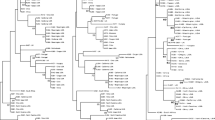Abstract
Using primers to amplify the gene AMP2 in Amaranthus caudatus, we found the gene to be present in seven other species of the Amaranthus genus (A. albus, A. cruentus, A. blitum, A. hybridus, A. hypochondriacus, A. retroflexus and A. tricolor), in which it had not been described previously. The PCR products were sequenced and it was established that all the sequences were identical, except for two polymorphisms. These single nucleotide polymorphisms occurred at nucleotide positions 45 and 246. This exchange of one nucleotide for another was manifested in an amino acid change in both cases. Due to the fact that both polymorphisms lay outside the region encoding the chitin-binding peptide domain, which is crucial for antimicrobial peptide function, they will not likely affect the proper functioning of the peptide. With the exception of the above-mentioned polymorphisms, all sequences were identical to the sequence of the AMP2 gene that codes for the A. caudatus Ac-AMP2 (antimicrobial peptide isolated from Amaranthus caudatus seeds). The detection of sequences with high degree of sequence similarity to A. caudatus AMP2 gene leads us to the assumption that an antimicrobial peptide could also be produced by other amaranth species.
Similar content being viewed by others
Abbreviations
- Ac-AMP peptide:
-
antimicrobial peptide isolated from Amaranthus caudatus seeds
References
Benson D.A., Karsch-Mizrachi I., Lipman D.J., Ostell J. & Wheeler D.L. 2007. GenBank. Nucleic Acids Res. 35 (Database Issue): D21–D25.
Broekaert W.F., Cammue B.P.A., De Bolle M.F.C., Thevissen K., De Samblanx G.W. & Osborn R.W. 1997. Antimicrobial peptides from plants. Crit. Rev. Plant Sci. 16: 297–323.
Broekaert W.F., Marien W., Terras F.R.G., De Bolle M.F.C., Proost P., Vandamme J., Dillen L., Claeys M., Rees S.B., Vanderleyden J. & Cammue B.P.A. 1992. Antimicrobial peptides from Amaranthus caudatus seeds with sequence homology to the cysteine glycine-rich domain of chitin-binding proteins. Biochemistry 31: 4308–4314.
Broekaert W.F., Terras F.R.G., Cammue B.P.A. & Osborn R.W. 1995. Plant defensins: novel antimicrobial peptides as components of the host defense system. Plant Physiol. 108: 1353–1358.
Cammue B.P.A., De Bolle M.F.C., Schoofs H.M.E., Terras F.R.G., Thevissen K., Osborn R.W., Rees S.B. & Broekaert W.F. 1994. Gene-encoded antimicrobial peptides from plants, pp. 91–106. In: Boman H.G. (ed.), Antimicrobial Peptides-No. 186 (Ciba Foundation Symposium), John Wiley & Sons, Ltd., Chichester.
De Bolle M.F.C., David K.M.M., Rees S.B., Vanderleyden J., Cammue B.P.A. & Broekaert W.F. 1993. Cloning and characterization of a cDNA encoding an antimicrobial chitin-binding protein from amaranth, Amaranthus caudatus. Plant Mol. Biol. 22: 1187–1190.
De Bolle M.F.C., Osborn R.W., Goderis I.J., Noe L., Acland D., Hart C.A., Torrekens S., Van Leuven F. & Broekaert W.F. 1996. Antimicrobial peptides from Mirabilis jalapa and Amaranthus caudatus: expression, processing, localization and biological activity in transgenic tobacco. Plant Mol. Biol. 31: 993–1008.
Faye L., Johnson K.D., Sturm A. & Chrispeels M.J. 1989. Structure, biosynthesis, and function of asparagine-linked glycans on plant glycoproteins. Physiol. Plant. 75: 309–314.
Liapkova N.S., Loskotova N.A., Maisurian A.N., Mazin V.V., Korableva N.P., Platonova T.A., Ladyzhenskaia E.P. & Evsiunina A.S. 2001. Isolation of genetically modified potato plant containing the gene of defensive peptide from Amaranthus. Prikl. Biokhim. Mikrobiol. 37: 349–354 (In Russian).
Lipkin A., Anisimova V., Nikonorova A., Babakov A., Krause E., Bienert M., Grishin E. & Egorov T. 2005. An antimicrobial peptide Ar-AMP from amaranth (Amaranthus retroflexus L.) seeds. Phytochemistry 66: 2426–2431.
Pribylova R., Pavlik I., Rozsypalova Z. & Bartos M. 2006. A PCR-based method for the detection of genetically modified potatoes by the gene ac2 from Amaranthus caudatus. Eur. food Res. Technol. bf 223: 139–142.
Thevissen K., Terras F.R. & Broekaert W.F. 1999. Permeabilization of fungal membranes by plant defensins inhibits fungal growth. Appl. Environ. Microbiol. 65: 5451–5458.
Thomma B.P.H.J., Cammue B.P.A. & Thevissen K. 2002. Plant defensins. Planta 216: 193–202.
Wilson I.G. 1997. Inhibition and facilitation of nucleic acid amplification. Appl. Environ. Microbiol. 63: 3741–3751.
Xu F. & Sun M. 2001. Comparative analysis of phylogenetic relationships of grain amaranths and their wild relatives (Amaranthus; Amaranthaceae) using internal transcribed spacer, amplified fragment length polymorphism, and double-primer fluorescent intersimple sequence repeat markers. Mol. Phylogenet. Evol. 21: 372–387.
Author information
Authors and Affiliations
Corresponding author
Rights and permissions
About this article
Cite this article
Pribylova, R., Kralik, P., Pisarikova, B. et al. Detection of the antimicrobial peptide gene in different Amaranthus species. Biologia 63, 217–220 (2008). https://doi.org/10.2478/s11756-008-0037-8
Received:
Accepted:
Published:
Issue Date:
DOI: https://doi.org/10.2478/s11756-008-0037-8




